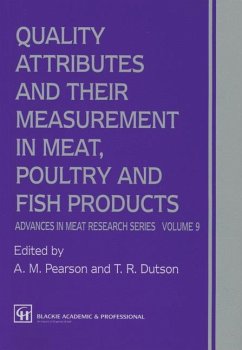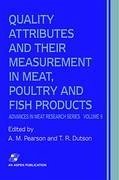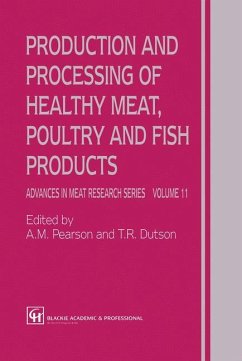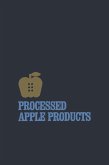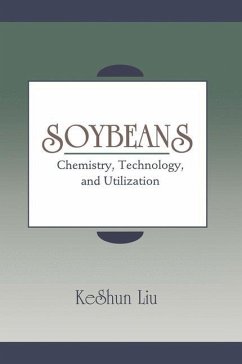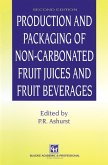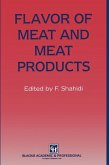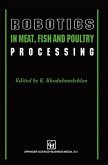A. M. Pearson
Quality Attributes and their Measurement in Meat, Poultry and Fish Products
A. M. Pearson
Quality Attributes and their Measurement in Meat, Poultry and Fish Products
- Broschiertes Buch
- Merkliste
- Auf die Merkliste
- Bewerten Bewerten
- Teilen
- Produkt teilen
- Produkterinnerung
- Produkterinnerung
The theme for this volume was chosen because no previous book has discussed the quality attributes of meat, poultry and fish and the methods that can be utilized for their measurement. The topics are not only timely but of great importance. Chapter I provides an introduction to the topic and presents a brief overview of the subject to be discussed. The next two chapters review information on the importance of color and some color problems in muscle foods, and explains the basis of color vision and perception of color before describing the methods that may be used for its measure ment. The…mehr
Andere Kunden interessierten sich auch für
![Quality Attributes and Their Measurement in Meat, Poultry and Fish Products Quality Attributes and Their Measurement in Meat, Poultry and Fish Products]() A. M. PearsonQuality Attributes and Their Measurement in Meat, Poultry and Fish Products161,99 €
A. M. PearsonQuality Attributes and Their Measurement in Meat, Poultry and Fish Products161,99 €![Production and Processing of Healthy Meat, Poultry and Fish Products Production and Processing of Healthy Meat, Poultry and Fish Products]() A. M. PearsonProduction and Processing of Healthy Meat, Poultry and Fish Products121,99 €
A. M. PearsonProduction and Processing of Healthy Meat, Poultry and Fish Products121,99 €![Processed Apple Products Processed Apple Products]() Processed Apple Products38,99 €
Processed Apple Products38,99 €![Soybeans Soybeans]() KeShun LiuSoybeans38,99 €
KeShun LiuSoybeans38,99 €![Production and Packaging of Non-Carbonated Fruit Juices and Fruit Beverages Production and Packaging of Non-Carbonated Fruit Juices and Fruit Beverages]() Production and Packaging of Non-Carbonated Fruit Juices and Fruit Beverages41,99 €
Production and Packaging of Non-Carbonated Fruit Juices and Fruit Beverages41,99 €![Flavor of Meat and Meat Products Flavor of Meat and Meat Products]() Flavor of Meat and Meat Products67,99 €
Flavor of Meat and Meat Products67,99 €![Robotics in Meat, Fish and Poultry Processing Robotics in Meat, Fish and Poultry Processing]() Robotics in Meat, Fish and Poultry Processing38,99 €
Robotics in Meat, Fish and Poultry Processing38,99 €-
-
-
The theme for this volume was chosen because no previous book has discussed the quality attributes of meat, poultry and fish and the methods that can be utilized for their measurement. The topics are not only timely but of great importance. Chapter I provides an introduction to the topic and presents a brief overview of the subject to be discussed. The next two chapters review information on the importance of color and some color problems in muscle foods, and explains the basis of color vision and perception of color before describing the methods that may be used for its measure ment. The following chapter discusses water binding and juiciness and their importance, while Chapter 5 provides the first intensive modern review on measurement of juiciness that has been published (to the knowledge of the author and editors). Chapter 6 reviews the physiology and psychology of flavor and aroma, which serves as a background for further discussion on the flavor and aroma of foods. The nextchapter discusses the chemistry of flavor and aroma in muscle foods, while measurement of flavor and aroma are covered in Chapter 8. Chapter 9 reviews the species-specific meat flavors and aromas. Chapter 10 reviews some flavor and aroma problems in muscle foods and their measurement.
Produktdetails
- Produktdetails
- Advances in Meat Research 9
- Verlag: Springer / Springer US / Springer, Berlin
- Artikelnr. des Verlages: 978-1-4613-5906-7
- 1994
- Seitenzahl: 524
- Erscheinungstermin: 23. März 2013
- Englisch
- Abmessung: 235mm x 155mm x 29mm
- Gewicht: 786g
- ISBN-13: 9781461359067
- ISBN-10: 1461359066
- Artikelnr.: 41320375
- Herstellerkennzeichnung Die Herstellerinformationen sind derzeit nicht verfügbar.
- Advances in Meat Research 9
- Verlag: Springer / Springer US / Springer, Berlin
- Artikelnr. des Verlages: 978-1-4613-5906-7
- 1994
- Seitenzahl: 524
- Erscheinungstermin: 23. März 2013
- Englisch
- Abmessung: 235mm x 155mm x 29mm
- Gewicht: 786g
- ISBN-13: 9781461359067
- ISBN-10: 1461359066
- Artikelnr.: 41320375
- Herstellerkennzeichnung Die Herstellerinformationen sind derzeit nicht verfügbar.
1 Introduction to quality attributes and their measurement in meat, poultry and fish products.- 1.1 Introduction.- 1.2 Color.- 1.2.1 Importance.- 1.2.2 Variability and measurement.- 1.3 Juiciness and/or water-binding.- 1.3.1 Importance.- 1.3.2 Effects of variability and measurement.- 1.4 Flavor.- 1.4.1 Importance.- 1.4.2 Variability.- 1.4.3 Physiology and psychology of flavor/aroma.- 1.4.4 Specific flavors/odors.- 1.4.5 Flavor and aroma problems.- 1.5 Tenderness.- 1.5.1 Importance.- 1.5.2 Some factors influencing tenderness and its measurement.- 1.6 Microbial problems.- 1.6.1 Importance.- 1.6.2 Measurement.- 1.7 Additives and residues.- 1.7.1 Additives.- 1.7.2 Residues.- 1.8 Contributions of meat to human nutrition.- 1.8.1 Proteins and essential amino acids.- 1.8.2 Fats and essential fatty acids.- 1.8.3 Vitamins.- 1.8.4 Minerals.- 1.9 Summary.- References.- Appendix 1.1.- Appendix 1.2.- 2 Color - its basis and importance.- 2.1 Introduction.- 2.1.1 Retail importance of meat color.- 2.2 Myoglobin and its derivatives.- 2.2.1 Myoglobin concentration in muscle.- 2.3 Factors affecting fresh meat color stability.- 2.3.1 Oxygen tension.- 2.3.2 Bacteria.- 2.3.3 Vacuum-packaging.- 2.3.4 Packaging with oxygen-permeable films.- 2.3.5 Modified-atmosphere packaging.- 2.3.6 Effects of pH.- 2.3.7 Temperature.- 2.4 Dark-cutting beef and related dark color problems.- 2.4.1 Characteristics of dark-cutting meat.- 2.4.2 Mechanism by which pH affects color.- 2.4.3 Changes occurring after death.- 2.4.4 Shelf-life of high pH meat.- 2.4.5 Vacuum packaging.- 2.4.6 Minimizing dark-cutters by management.- 2.4.7 Dark, coarse band in beef ribs.- 2.5 Pale, soft, exudative (PSE), porcine stress syndrome (PSS) and dark, firm, dry (DFD) pork'.- 2.5.1 Importance ofPSE, PSS and DFD pork.- 2.5.2Genetic basis.- 2.5.3 Influence of environmental factors.- 2.6 Enzymatic reduction of metmyoglobin.- 2.6.1 Enzymes involved.- 2.6.2 Variation among muscles.- 2.6.3 Other factors influencing color stability.- 2.7 Non-enzymatic reductants and inhibitors of oxidation.- 2.7.1 Effects of antioxidants and reductants.- 2.8 Irradiation and other antimicrobial treatments.- 2.8.1 Irradiation of fresh and cooked meats.- 2.8.2 Sulfites and meat color.- 2.9 Effects of light, freezing, salt and lipid oxidation on meat color.- 2.10 Cooked meat color.- 2.10.1 Pink color in cooked, uncured meat.- 2.11 Cured meat color.- 2.11.1 Role of nitrite.- 2.11.2 Action of cysteine and ascorbate.- 2.11.3 The cured meat pigment.- 2.11.4 Fading of cured meat color.- 2.12 Summary.- References.- 3 Colour of meat.- 3.1 Introduction to vision and colour.- 3.2 Colour vision.- 3.2.1 Colour measurement.- 3.2.2 Uniform colour space.- 3.3 Terminology.- 3.4 Instrumentation.- 3.4.1 Trichromatic colorimeters.- 3.4.2 Spectrophotometers.- 3.4.3 Sources of variation among colorimeters and spectrophotometers.- 3.5 Absorption, scatter and pigmentation.- 3.5. 1 Reflectance.- 3.5.2 Light scatter.- 3.6 Meat colour.- 3.6.1 Measurement procedure.- 3.6.2 Reflectance spectral changes in meat.- 3.6.3 Colour changes in beef.- 3.6.4 Differences between CIELAB and Hunter scales.- 3.7 Summary.- References.- 4 Juiciness - its importance and some contributing factors.- 4.1 Introduction.- 4.2 Subjective assessment of juiciness.- 4.3 Relationship to objective measurements.- 4.3.1 Juiciness vs. water-holding.- 4.3.2 The state of water.- 4.3 .3 Heating method and end-point temperature vs. juiciness.- 4.3.4 The role of fat.- 4.3.5 Relationship between drip losses and juiciness.- 4.3.6 Relationship between press fluid and juiciness.- 4.4 Factors influencing the juiciness of intact meat.- 4.4.1 Interference from other experimental and textural factors.- 4.4.2 Heating/cooking methods.- 4.4.3 Animal characteristics.- 4.4.4 Factors related to rigor development.- 4.4.5 Restructured meat.- 4.4.6 Processed meats.- 4.4.7 Marinaded meat.- 4.5 Conclusions.- References.- 5 Measurement of water-holding capacity and juiciness.- 5.1 Introduction.- 5.2 Composition and structure of meat.- 5.3 State of water in meat.- 5.4 Definition of water-holding capacity.- 5.5 General methodology.- 5.5.1 Applying no force.- 5.5.2 Applying external mechanical force.- 5.5.3 Applying thermal force.- 5.5.4 Choosing a method for measuring WHC.- 5.6 Influence of different factors on WHC.- 5.6.1 Evaporation losses.- 5.6.2 Drip losses.- 5.6.3 Filter paper press method (FPPM).- 5.6.4 Centrifugation methods for uncooked meat.- 5.6.5 Capillary volumeter method.- 5.6.6 Imbibing method.- 5.6.7 Cooking losses.- 5.7 Description of methods and evaluation.- 5.7.1 Drip loss determination.- 5.7.2 Determination of water-holding capacity using the filter paper press method (FPPM).- 5.7.3 Determination of water-holding capacity by centrifugation.- 5.7.4 Capillary volumeter measurements.- 5.7.5 Imbibing method.- 5.7.6 Cooking loss measurement.- 5.8 Meat products.- 5.8.1 Manufacturing of cooked sausage.- 5.8.2 Water-holding capacity of unheated batters.- 5.8.3 Water-holding capacity of heated batters.- 5.8.4 Measurement of water-holding capacity in sausage batters.- 5.8.5 Evaluation of methods.- 5.9 Conclusions about water-holding capacity measurements.- 5.10 Measurement of juiciness.- 5.10.1 Problems in evaluating juiciness.- 5.10.2 Evaluation of methods.- 5.11 Summary.- References.- 6 The chemical senses.- 6.1 Introduction.- 6.2 Anatomy and physiologyof the chemical senses: taste.- 6.2.1 Overview..- 6.2.2 Anatomy.- 6.2.3 Reception and transduction.- 6.3 Anatomy and physiology of the chemical senses: olfaction.- 6.3.1 Overview.- 6.3.2 Anatomy.- 6.3.3 Reception and transduction.- 6.4 Sensory responses to food: taste.- 6.4.1 Development of taste preference.- 6.4.2 Effects of aging.- 6.5 Sensory responses to food: olfaction.- 6.5.1 Development of olfactory preference.- 6.5.2 Effects of aging.- 6.6 Specific appetites.- 6.6.1 Salt.- 6.6.2 Amino acids and proteins.- 6.7 Chemosensory mixtures.- 6.8 Conclusions.- References.- Acknowledgements.- 7 Flavor and aroma chemistry.- 7.1 Introduction.- 7.2 Flavor precursors.- 7.3 The taste of meat.- 7.4 Meat aroma.- 7.4.1 Maillard reaction.- 7.4.2 Lipid reactions.- 7.4.3 Thiamin degradation.- 7.4.4 Role of nitrite in cured meat flavor.- 7.4.5 Volatiles and flavor.- 7.5 Summary.- References.- 8 Flavor and aroma - its measurement.- 8.1 Introduction.- 8.2 Difference tests.- 8.3 Descriptive flavor analysis.- 8.3.1 The flavor profile.- 8.3.2 Quantitative descriptive analysis.- 8.3.3 The spectrum method.- 8.4 Instrumental analysis.- 8.4.1 Extraction and concentration of flavor compounds.- 8.4.2 Selection of a concentration- extraction procedure.- 8.4.3 Gas chromatographic (GC) analysis.- 8.4.4 Sniffer-port analysis.- 8.4.5 Flavor analysis by HPLC.- 8.4.6 Piezo-electric crystals.- 8.5 Correlation between sensory analysis and gas chromatography.- 8.5.1 Principal component analysis.- 8.5.2 Factor analysis.- 8.5.3 Cluster analysis.- 8.5.4 Discriminant analysis.- 8.5.5 Regression and correlation.- 8.5.6 Response surface methodology.- 8.5.7 Neural networks.- 8.6 Analysis of an example data-set.- 8.6.1 Description of data.- 8.6.2 Statistical methods.- 8.6.3 Results of statistical analysis.- 8.7Summary.- References.- Acknowledgements.- 9 Species-specific flavors and odors.- 9.1 Introduction.- 9.2 Fatty acids in meats.- 9.2.1 Influence of cooking on the fatty acid composition of meat.- 9.2.2 Volatile free fatty acids and some other possible flavor compounds.- 9.2.3 Free fatty acids in meat.- 9.2.4 Branched-chain fatty acids (BCFAs).- 9.3 Subcutaneous and perinephric adipose tissue.- 9.4 Synthesis of branched-chain fatty acids.- 9.4.1 Effects of diet on synthesis of branched-chain fatty acids.- 9.4.2 Body secretions of branched-chain fatty acids by meat-producing animals.- 9.4.3 Odors and flavors of some selected fatty acids.- 9.4.4 Determination of the concentration of short-chain and branchedchain fatty acids.- 9.4.5 Measurement of alkylphenols and thiophenols.- 9.5 Other flavor or odor compounds localized in the fatty tissues.- 9.5.1 Sex odor or boar 'taint'.- 9.5.2 Pathways for Cw .1. 16-steroid production.- 9.5.3 Thresholds and odors of the Cw .1. 16-steroids.- 9.5.4 Identification and quantification of the Cw .1. 16-steroids.- 9.5.5 Possible role of skatole.- 9.5.6 Isolation and quantification of skatole.- 9.6 Species-specific flavors.- 9.6.1 Lamb and/or mutton flavor.- 9.6.2 Goaty flavors and odors.- 9.6.3 Odors and flavors in pork.- 9.6.4 Beef and veal flavors and odors.- 9.6.5 Chicken- and turkey-specific flavors and odors.- 9.6.6 Fish-specific flavors and odors.- 9.6.7 'Gamey' flavors and odors.- 9.7 Summary.- References.- 10 Flavor and aroma problems and their measurement in meat, poultry and fish products.- 10.1 Introduction.- 10.2 Oxidative rancidity/wanned over flavors.- 10.2.1 Lipid oxidation and meat quality.- 10.2.2 Inhibiting lipid oxidation.- 10.2.3 Effect of lipid oxidation on meat flavor.- 10.2.4 Catalysis of lipid oxidation inmeats.- 10.2.5 Measurement of lipid oxidation in meats.- 10.3 Species-specific flavors.- 10.4 Effects of differertt feeds on flavor and aroma.- 10.4.1 Lamb and mutton.- 10.4.2 Veal and beef.- 10.4.3 Pig meat.- 10.4.4 Fish.- 10.4.5 Poultry.- 10.4.6 Other species.- 10.5 'Gamey' flavors.- 10.6 Off flavors due to sex condition.- 10.6.1 Boar odor or taint.- 10.6.2 Ram odor/flavor.- 10.6.3 Sex flavor/aroma in other species.- 10.7 Off-flavors from the environment.- 10.8 Processing-induced off-flavors.- 10.8.1 Irradiation flavor/odor.- 10.8.2 Retort flavor of canned meat.- 10.9 Off-flavors associated with microbial growth.- 10.9.1 Off-odors in fish caused by microbial growth.- 10.9.2 Off-odors and flavors in poultry associated with microbial growth.- 10.9.3 Off-odors and flavors produced in red meats by microbial growth.- 10.10 Summary.- References.- 11 Tenderness of meat, poultry and fish.- 11.1 Introduction.- 11.2 Pre-slaughter factors.- 11.2.1 Breed effects.- 11.2.2 Fatness.- 11.2.3 Sex effects.- 11.2.4 Growth promoters.- 11.2.5 Connective tissue.- 11.3 Slaughtering.- 11.4 Rigor development.- 11.4.1 Compositional and structural changes post-mortem.- 11.4.2 Temperature effects.- 11.4.3 Electrical stimulation.- 11.5 Muscle shortening.- 11.5.1 Relationship between muscle shortening and tenderness.- 11.5.2 Carcass suspension effects.- 11.5.3 Hot-deboning.- 11.5.4 Pre-rigor cooking.- 11.5.5 Pre-rigor cooling.- 11.5.6 Electrical stimulation.- 11.6 Ultimate pH effects.- 11.7 Effects of post-rigor storage.- 11.7.1 Mechanism of tenderisation.- 11.7.2 Pre-slaughter factors.- 11.7.3 Influence of muscle-shortening.- 11.7.4 Temperature.- 11.8 Artificial tenderisation.- 11.8.1 Proteolytic enzymes.- 11.8.2 Marinading.- 11.8.3 Pressure treatment.- 11.9 Control of tenderness.- 11.10Summary and research needs..- References.- 12 Meat texture measurement.- 12.1 Introduction.- 12.2 Why measure tenderness and when?.- 12.3 Subjective assessments.- 12.4 Objective assessments.- 12.4.1 Shear and biting systems.- 12.4.2 Compression methods.- 12.4.3 Tensile assessments.- 12.4.4 Penetration methods.- 12.4.5 Grinding methods.- 12.4.6 Fragmentation methods.- 12.5 Structural assessments.- 12.6 Chemical measures.- 12.7 Other methods.- 12.8 Samples.- 12.9 Standard protocols.- 12.10 Relationships between assessment methods.- 12.10.1 Between objective assessments.- 12.10.2 Between objective and subjective assessments.- 12.11 Conclusions.- References.- 13 Product acceptability evaluation.- 13.1 Introduction.- 13.2 Affective testing: testing for acceptance and preference.- 13.2.1 Scaling.- 13.2.2 Direct preference tests.- 13.3 Affective vs. analytical sensory testing.- 13.4 Subjects in acceptance tests: the usefulness of trained panels or experts in evaluating product acceptability.- 13.5 Relating sensory attributes to product acceptability.- 13.5.1 Hedonic scores and intensity of sensory attributes.- 13.5.2 Fat level as a determinant of acceptability.- 13.5.3 Factors that alter the relative importance of appearance, texture and flavor in consumer acceptance studies.- 13.6 Factors affecting the outcome of acceptance tests.- 13.6.1 Type of test or method 35213.6.2 Context effects.- 13.6.3 Design and control of experiments.- 13.7 Summary.- References.- 14 Microbial growth and its control in meat, poultry and fish.- 14.1 Introduction.- 14.2 Microbial contamination of muscle foods.- 14.2.1 Sources of contamination.- 14.2.2 Types of contamination.- 14.3 Microbial effects'on muscle foods.- 14.3.1 Spoilage.- 14.3.2 Foodborne illness.- 14.4 Control of microbial growth inmuscle foods.- 14.4.1 General.- 14.4.2 Decontamination.- 14.4.3 Modified-atmosphere storage.- 14.4.4 Biopreservation.- 14.5 Summary.- References.- 15 Rapid methods for measurement and enumeration of microbial contamination.- 15.1 Introduction.- 15.2 Improvements in sampling and sample preparation.- 15.2.1 Stomacher.- 15.2.2 Hand roller.- 15.2.3 Gravimetric Diluter or Diluflo.- 15.2.4 Other methods.- 15.3 Alternative methods for viable cell count procedure.- 15.3.1 The spiral plating method.- 15.3.2 The Isogrid system.- 15.3.3 The Petrifilm system.- 15.3.4 The Redigel system.- 15.3.5 The Direct Epifluorescent Filter Technique.- 15.3.6 Double-tube method.- 15.4 New methods for estimation of microbial populations.- 15.4.1 ATP estimation.- 15.4.2 Impedance and conductance measurements.- 15.4.3 Radiometry and calorimetry.- 15.4.4 Reflectance colorimetry.- 15.4.5 Limulus amoebocyte lysate and catalase tests.- 15.5 Miniaturized microbiological techniques.- 15.6 New and novel techniques.- 15.6.1 Vitek system.- 15.6.2 DNA probes.- 15.6.3 Target RNA probes.- 15.6.4 ELISA tests.- 15.6.5 The VIDAS immunoanalysis system.- 15.6.6 The polymerase chain reaction.- 15.6.7 Motility enrichment.- 15.6.8 Oxyrase enzyme system.- 15.7 Conclusions.- Acknowledgement.- References.- 16 Food analysis and chemical residues in muscle foods.- 16.1 Food analysis.- 16.1.1 Introduction.- 16.1.2 Protein.- 16.1.3 Fat.- 16.1.4 Moisture.- 16.1.5 Salt.- 16.1.6 Sugars.- 16.1.7 Nitrate.- 16.1.8 Nitrite.- 16.1.9 Nitrosamines.- 16.1.10 Cholesterol.- 16.1.11 Rapid test methods.- 16.2 Chemical residues.- 16.2.1 Introduction.- 16.2.2 Pesticide-residue analysis.- 16.2.3 Volatile environmental contaminants.- 16.2.4 Halophenols.- 16.2.5 Veterinary drug residue analysis.- 16.3 Summary.- Acknowledgements.- References.-17 The contributions of meat, poultry and fish to the health and well being of man.- 17.1 Introduction.- 17.2 Consumption of meat, poultry and fish.- 17.2.1 Factors affecting consumption of meat, poultry and fish.- 17.2.2 How consumption of meat, poultry and fish contributes to nutrient intake.- 17.3 The nutritional value of meat, poultry and fish.- 17.3.1 Criteria for what makes a food 'nutritious'.- 17.3.2 Specific nutrients supplied by meat, poultry and fish.- 17.4 The role of meat, poultry and fish in human health.- 17.4.1 Meat, poultry and fish and their relationship to heart disease.- 17.4.2 Meat, poultry and fish and their relationship to cancer.- 17.5 Summary.- Acknowledgement.- References.
Introduction To Quality Attributes In Meat, Poultry And Fish Products.
Color. Its Basis and Importance. Color of Meat. Juiciness. Its Importance
and Some Contributing Factors. Measurements of Waterholding Capacity and
Juiciness. The Chemical Senses. Flavor and Aroma Chemistry. Flavor and
Aroma. Its Measurement. Species. Specific Flavors and Odors. Tenderness of
Meat, Poultry and Fish. Meat Texture Measurement. Product Acceptability
Evaluation. Microbial Growth and Its Control in Meat, Poultry and Fish.
Rapid Methods for Measurement and Enumeration of Microbial Contamination.
Food Analysis and Chemical Residues in Muscle Foods. The Contributions of
Meat, Poultry and Fish to the Health and Well Being of Man. Index
Color. Its Basis and Importance. Color of Meat. Juiciness. Its Importance
and Some Contributing Factors. Measurements of Waterholding Capacity and
Juiciness. The Chemical Senses. Flavor and Aroma Chemistry. Flavor and
Aroma. Its Measurement. Species. Specific Flavors and Odors. Tenderness of
Meat, Poultry and Fish. Meat Texture Measurement. Product Acceptability
Evaluation. Microbial Growth and Its Control in Meat, Poultry and Fish.
Rapid Methods for Measurement and Enumeration of Microbial Contamination.
Food Analysis and Chemical Residues in Muscle Foods. The Contributions of
Meat, Poultry and Fish to the Health and Well Being of Man. Index
1 Introduction to quality attributes and their measurement in meat, poultry and fish products.- 1.1 Introduction.- 1.2 Color.- 1.2.1 Importance.- 1.2.2 Variability and measurement.- 1.3 Juiciness and/or water-binding.- 1.3.1 Importance.- 1.3.2 Effects of variability and measurement.- 1.4 Flavor.- 1.4.1 Importance.- 1.4.2 Variability.- 1.4.3 Physiology and psychology of flavor/aroma.- 1.4.4 Specific flavors/odors.- 1.4.5 Flavor and aroma problems.- 1.5 Tenderness.- 1.5.1 Importance.- 1.5.2 Some factors influencing tenderness and its measurement.- 1.6 Microbial problems.- 1.6.1 Importance.- 1.6.2 Measurement.- 1.7 Additives and residues.- 1.7.1 Additives.- 1.7.2 Residues.- 1.8 Contributions of meat to human nutrition.- 1.8.1 Proteins and essential amino acids.- 1.8.2 Fats and essential fatty acids.- 1.8.3 Vitamins.- 1.8.4 Minerals.- 1.9 Summary.- References.- Appendix 1.1.- Appendix 1.2.- 2 Color - its basis and importance.- 2.1 Introduction.- 2.1.1 Retail importance of meat color.- 2.2 Myoglobin and its derivatives.- 2.2.1 Myoglobin concentration in muscle.- 2.3 Factors affecting fresh meat color stability.- 2.3.1 Oxygen tension.- 2.3.2 Bacteria.- 2.3.3 Vacuum-packaging.- 2.3.4 Packaging with oxygen-permeable films.- 2.3.5 Modified-atmosphere packaging.- 2.3.6 Effects of pH.- 2.3.7 Temperature.- 2.4 Dark-cutting beef and related dark color problems.- 2.4.1 Characteristics of dark-cutting meat.- 2.4.2 Mechanism by which pH affects color.- 2.4.3 Changes occurring after death.- 2.4.4 Shelf-life of high pH meat.- 2.4.5 Vacuum packaging.- 2.4.6 Minimizing dark-cutters by management.- 2.4.7 Dark, coarse band in beef ribs.- 2.5 Pale, soft, exudative (PSE), porcine stress syndrome (PSS) and dark, firm, dry (DFD) pork'.- 2.5.1 Importance ofPSE, PSS and DFD pork.- 2.5.2Genetic basis.- 2.5.3 Influence of environmental factors.- 2.6 Enzymatic reduction of metmyoglobin.- 2.6.1 Enzymes involved.- 2.6.2 Variation among muscles.- 2.6.3 Other factors influencing color stability.- 2.7 Non-enzymatic reductants and inhibitors of oxidation.- 2.7.1 Effects of antioxidants and reductants.- 2.8 Irradiation and other antimicrobial treatments.- 2.8.1 Irradiation of fresh and cooked meats.- 2.8.2 Sulfites and meat color.- 2.9 Effects of light, freezing, salt and lipid oxidation on meat color.- 2.10 Cooked meat color.- 2.10.1 Pink color in cooked, uncured meat.- 2.11 Cured meat color.- 2.11.1 Role of nitrite.- 2.11.2 Action of cysteine and ascorbate.- 2.11.3 The cured meat pigment.- 2.11.4 Fading of cured meat color.- 2.12 Summary.- References.- 3 Colour of meat.- 3.1 Introduction to vision and colour.- 3.2 Colour vision.- 3.2.1 Colour measurement.- 3.2.2 Uniform colour space.- 3.3 Terminology.- 3.4 Instrumentation.- 3.4.1 Trichromatic colorimeters.- 3.4.2 Spectrophotometers.- 3.4.3 Sources of variation among colorimeters and spectrophotometers.- 3.5 Absorption, scatter and pigmentation.- 3.5. 1 Reflectance.- 3.5.2 Light scatter.- 3.6 Meat colour.- 3.6.1 Measurement procedure.- 3.6.2 Reflectance spectral changes in meat.- 3.6.3 Colour changes in beef.- 3.6.4 Differences between CIELAB and Hunter scales.- 3.7 Summary.- References.- 4 Juiciness - its importance and some contributing factors.- 4.1 Introduction.- 4.2 Subjective assessment of juiciness.- 4.3 Relationship to objective measurements.- 4.3.1 Juiciness vs. water-holding.- 4.3.2 The state of water.- 4.3 .3 Heating method and end-point temperature vs. juiciness.- 4.3.4 The role of fat.- 4.3.5 Relationship between drip losses and juiciness.- 4.3.6 Relationship between press fluid and juiciness.- 4.4 Factors influencing the juiciness of intact meat.- 4.4.1 Interference from other experimental and textural factors.- 4.4.2 Heating/cooking methods.- 4.4.3 Animal characteristics.- 4.4.4 Factors related to rigor development.- 4.4.5 Restructured meat.- 4.4.6 Processed meats.- 4.4.7 Marinaded meat.- 4.5 Conclusions.- References.- 5 Measurement of water-holding capacity and juiciness.- 5.1 Introduction.- 5.2 Composition and structure of meat.- 5.3 State of water in meat.- 5.4 Definition of water-holding capacity.- 5.5 General methodology.- 5.5.1 Applying no force.- 5.5.2 Applying external mechanical force.- 5.5.3 Applying thermal force.- 5.5.4 Choosing a method for measuring WHC.- 5.6 Influence of different factors on WHC.- 5.6.1 Evaporation losses.- 5.6.2 Drip losses.- 5.6.3 Filter paper press method (FPPM).- 5.6.4 Centrifugation methods for uncooked meat.- 5.6.5 Capillary volumeter method.- 5.6.6 Imbibing method.- 5.6.7 Cooking losses.- 5.7 Description of methods and evaluation.- 5.7.1 Drip loss determination.- 5.7.2 Determination of water-holding capacity using the filter paper press method (FPPM).- 5.7.3 Determination of water-holding capacity by centrifugation.- 5.7.4 Capillary volumeter measurements.- 5.7.5 Imbibing method.- 5.7.6 Cooking loss measurement.- 5.8 Meat products.- 5.8.1 Manufacturing of cooked sausage.- 5.8.2 Water-holding capacity of unheated batters.- 5.8.3 Water-holding capacity of heated batters.- 5.8.4 Measurement of water-holding capacity in sausage batters.- 5.8.5 Evaluation of methods.- 5.9 Conclusions about water-holding capacity measurements.- 5.10 Measurement of juiciness.- 5.10.1 Problems in evaluating juiciness.- 5.10.2 Evaluation of methods.- 5.11 Summary.- References.- 6 The chemical senses.- 6.1 Introduction.- 6.2 Anatomy and physiologyof the chemical senses: taste.- 6.2.1 Overview..- 6.2.2 Anatomy.- 6.2.3 Reception and transduction.- 6.3 Anatomy and physiology of the chemical senses: olfaction.- 6.3.1 Overview.- 6.3.2 Anatomy.- 6.3.3 Reception and transduction.- 6.4 Sensory responses to food: taste.- 6.4.1 Development of taste preference.- 6.4.2 Effects of aging.- 6.5 Sensory responses to food: olfaction.- 6.5.1 Development of olfactory preference.- 6.5.2 Effects of aging.- 6.6 Specific appetites.- 6.6.1 Salt.- 6.6.2 Amino acids and proteins.- 6.7 Chemosensory mixtures.- 6.8 Conclusions.- References.- Acknowledgements.- 7 Flavor and aroma chemistry.- 7.1 Introduction.- 7.2 Flavor precursors.- 7.3 The taste of meat.- 7.4 Meat aroma.- 7.4.1 Maillard reaction.- 7.4.2 Lipid reactions.- 7.4.3 Thiamin degradation.- 7.4.4 Role of nitrite in cured meat flavor.- 7.4.5 Volatiles and flavor.- 7.5 Summary.- References.- 8 Flavor and aroma - its measurement.- 8.1 Introduction.- 8.2 Difference tests.- 8.3 Descriptive flavor analysis.- 8.3.1 The flavor profile.- 8.3.2 Quantitative descriptive analysis.- 8.3.3 The spectrum method.- 8.4 Instrumental analysis.- 8.4.1 Extraction and concentration of flavor compounds.- 8.4.2 Selection of a concentration- extraction procedure.- 8.4.3 Gas chromatographic (GC) analysis.- 8.4.4 Sniffer-port analysis.- 8.4.5 Flavor analysis by HPLC.- 8.4.6 Piezo-electric crystals.- 8.5 Correlation between sensory analysis and gas chromatography.- 8.5.1 Principal component analysis.- 8.5.2 Factor analysis.- 8.5.3 Cluster analysis.- 8.5.4 Discriminant analysis.- 8.5.5 Regression and correlation.- 8.5.6 Response surface methodology.- 8.5.7 Neural networks.- 8.6 Analysis of an example data-set.- 8.6.1 Description of data.- 8.6.2 Statistical methods.- 8.6.3 Results of statistical analysis.- 8.7Summary.- References.- Acknowledgements.- 9 Species-specific flavors and odors.- 9.1 Introduction.- 9.2 Fatty acids in meats.- 9.2.1 Influence of cooking on the fatty acid composition of meat.- 9.2.2 Volatile free fatty acids and some other possible flavor compounds.- 9.2.3 Free fatty acids in meat.- 9.2.4 Branched-chain fatty acids (BCFAs).- 9.3 Subcutaneous and perinephric adipose tissue.- 9.4 Synthesis of branched-chain fatty acids.- 9.4.1 Effects of diet on synthesis of branched-chain fatty acids.- 9.4.2 Body secretions of branched-chain fatty acids by meat-producing animals.- 9.4.3 Odors and flavors of some selected fatty acids.- 9.4.4 Determination of the concentration of short-chain and branchedchain fatty acids.- 9.4.5 Measurement of alkylphenols and thiophenols.- 9.5 Other flavor or odor compounds localized in the fatty tissues.- 9.5.1 Sex odor or boar 'taint'.- 9.5.2 Pathways for Cw .1. 16-steroid production.- 9.5.3 Thresholds and odors of the Cw .1. 16-steroids.- 9.5.4 Identification and quantification of the Cw .1. 16-steroids.- 9.5.5 Possible role of skatole.- 9.5.6 Isolation and quantification of skatole.- 9.6 Species-specific flavors.- 9.6.1 Lamb and/or mutton flavor.- 9.6.2 Goaty flavors and odors.- 9.6.3 Odors and flavors in pork.- 9.6.4 Beef and veal flavors and odors.- 9.6.5 Chicken- and turkey-specific flavors and odors.- 9.6.6 Fish-specific flavors and odors.- 9.6.7 'Gamey' flavors and odors.- 9.7 Summary.- References.- 10 Flavor and aroma problems and their measurement in meat, poultry and fish products.- 10.1 Introduction.- 10.2 Oxidative rancidity/wanned over flavors.- 10.2.1 Lipid oxidation and meat quality.- 10.2.2 Inhibiting lipid oxidation.- 10.2.3 Effect of lipid oxidation on meat flavor.- 10.2.4 Catalysis of lipid oxidation inmeats.- 10.2.5 Measurement of lipid oxidation in meats.- 10.3 Species-specific flavors.- 10.4 Effects of differertt feeds on flavor and aroma.- 10.4.1 Lamb and mutton.- 10.4.2 Veal and beef.- 10.4.3 Pig meat.- 10.4.4 Fish.- 10.4.5 Poultry.- 10.4.6 Other species.- 10.5 'Gamey' flavors.- 10.6 Off flavors due to sex condition.- 10.6.1 Boar odor or taint.- 10.6.2 Ram odor/flavor.- 10.6.3 Sex flavor/aroma in other species.- 10.7 Off-flavors from the environment.- 10.8 Processing-induced off-flavors.- 10.8.1 Irradiation flavor/odor.- 10.8.2 Retort flavor of canned meat.- 10.9 Off-flavors associated with microbial growth.- 10.9.1 Off-odors in fish caused by microbial growth.- 10.9.2 Off-odors and flavors in poultry associated with microbial growth.- 10.9.3 Off-odors and flavors produced in red meats by microbial growth.- 10.10 Summary.- References.- 11 Tenderness of meat, poultry and fish.- 11.1 Introduction.- 11.2 Pre-slaughter factors.- 11.2.1 Breed effects.- 11.2.2 Fatness.- 11.2.3 Sex effects.- 11.2.4 Growth promoters.- 11.2.5 Connective tissue.- 11.3 Slaughtering.- 11.4 Rigor development.- 11.4.1 Compositional and structural changes post-mortem.- 11.4.2 Temperature effects.- 11.4.3 Electrical stimulation.- 11.5 Muscle shortening.- 11.5.1 Relationship between muscle shortening and tenderness.- 11.5.2 Carcass suspension effects.- 11.5.3 Hot-deboning.- 11.5.4 Pre-rigor cooking.- 11.5.5 Pre-rigor cooling.- 11.5.6 Electrical stimulation.- 11.6 Ultimate pH effects.- 11.7 Effects of post-rigor storage.- 11.7.1 Mechanism of tenderisation.- 11.7.2 Pre-slaughter factors.- 11.7.3 Influence of muscle-shortening.- 11.7.4 Temperature.- 11.8 Artificial tenderisation.- 11.8.1 Proteolytic enzymes.- 11.8.2 Marinading.- 11.8.3 Pressure treatment.- 11.9 Control of tenderness.- 11.10Summary and research needs..- References.- 12 Meat texture measurement.- 12.1 Introduction.- 12.2 Why measure tenderness and when?.- 12.3 Subjective assessments.- 12.4 Objective assessments.- 12.4.1 Shear and biting systems.- 12.4.2 Compression methods.- 12.4.3 Tensile assessments.- 12.4.4 Penetration methods.- 12.4.5 Grinding methods.- 12.4.6 Fragmentation methods.- 12.5 Structural assessments.- 12.6 Chemical measures.- 12.7 Other methods.- 12.8 Samples.- 12.9 Standard protocols.- 12.10 Relationships between assessment methods.- 12.10.1 Between objective assessments.- 12.10.2 Between objective and subjective assessments.- 12.11 Conclusions.- References.- 13 Product acceptability evaluation.- 13.1 Introduction.- 13.2 Affective testing: testing for acceptance and preference.- 13.2.1 Scaling.- 13.2.2 Direct preference tests.- 13.3 Affective vs. analytical sensory testing.- 13.4 Subjects in acceptance tests: the usefulness of trained panels or experts in evaluating product acceptability.- 13.5 Relating sensory attributes to product acceptability.- 13.5.1 Hedonic scores and intensity of sensory attributes.- 13.5.2 Fat level as a determinant of acceptability.- 13.5.3 Factors that alter the relative importance of appearance, texture and flavor in consumer acceptance studies.- 13.6 Factors affecting the outcome of acceptance tests.- 13.6.1 Type of test or method 35213.6.2 Context effects.- 13.6.3 Design and control of experiments.- 13.7 Summary.- References.- 14 Microbial growth and its control in meat, poultry and fish.- 14.1 Introduction.- 14.2 Microbial contamination of muscle foods.- 14.2.1 Sources of contamination.- 14.2.2 Types of contamination.- 14.3 Microbial effects'on muscle foods.- 14.3.1 Spoilage.- 14.3.2 Foodborne illness.- 14.4 Control of microbial growth inmuscle foods.- 14.4.1 General.- 14.4.2 Decontamination.- 14.4.3 Modified-atmosphere storage.- 14.4.4 Biopreservation.- 14.5 Summary.- References.- 15 Rapid methods for measurement and enumeration of microbial contamination.- 15.1 Introduction.- 15.2 Improvements in sampling and sample preparation.- 15.2.1 Stomacher.- 15.2.2 Hand roller.- 15.2.3 Gravimetric Diluter or Diluflo.- 15.2.4 Other methods.- 15.3 Alternative methods for viable cell count procedure.- 15.3.1 The spiral plating method.- 15.3.2 The Isogrid system.- 15.3.3 The Petrifilm system.- 15.3.4 The Redigel system.- 15.3.5 The Direct Epifluorescent Filter Technique.- 15.3.6 Double-tube method.- 15.4 New methods for estimation of microbial populations.- 15.4.1 ATP estimation.- 15.4.2 Impedance and conductance measurements.- 15.4.3 Radiometry and calorimetry.- 15.4.4 Reflectance colorimetry.- 15.4.5 Limulus amoebocyte lysate and catalase tests.- 15.5 Miniaturized microbiological techniques.- 15.6 New and novel techniques.- 15.6.1 Vitek system.- 15.6.2 DNA probes.- 15.6.3 Target RNA probes.- 15.6.4 ELISA tests.- 15.6.5 The VIDAS immunoanalysis system.- 15.6.6 The polymerase chain reaction.- 15.6.7 Motility enrichment.- 15.6.8 Oxyrase enzyme system.- 15.7 Conclusions.- Acknowledgement.- References.- 16 Food analysis and chemical residues in muscle foods.- 16.1 Food analysis.- 16.1.1 Introduction.- 16.1.2 Protein.- 16.1.3 Fat.- 16.1.4 Moisture.- 16.1.5 Salt.- 16.1.6 Sugars.- 16.1.7 Nitrate.- 16.1.8 Nitrite.- 16.1.9 Nitrosamines.- 16.1.10 Cholesterol.- 16.1.11 Rapid test methods.- 16.2 Chemical residues.- 16.2.1 Introduction.- 16.2.2 Pesticide-residue analysis.- 16.2.3 Volatile environmental contaminants.- 16.2.4 Halophenols.- 16.2.5 Veterinary drug residue analysis.- 16.3 Summary.- Acknowledgements.- References.-17 The contributions of meat, poultry and fish to the health and well being of man.- 17.1 Introduction.- 17.2 Consumption of meat, poultry and fish.- 17.2.1 Factors affecting consumption of meat, poultry and fish.- 17.2.2 How consumption of meat, poultry and fish contributes to nutrient intake.- 17.3 The nutritional value of meat, poultry and fish.- 17.3.1 Criteria for what makes a food 'nutritious'.- 17.3.2 Specific nutrients supplied by meat, poultry and fish.- 17.4 The role of meat, poultry and fish in human health.- 17.4.1 Meat, poultry and fish and their relationship to heart disease.- 17.4.2 Meat, poultry and fish and their relationship to cancer.- 17.5 Summary.- Acknowledgement.- References.
Introduction To Quality Attributes In Meat, Poultry And Fish Products.
Color. Its Basis and Importance. Color of Meat. Juiciness. Its Importance
and Some Contributing Factors. Measurements of Waterholding Capacity and
Juiciness. The Chemical Senses. Flavor and Aroma Chemistry. Flavor and
Aroma. Its Measurement. Species. Specific Flavors and Odors. Tenderness of
Meat, Poultry and Fish. Meat Texture Measurement. Product Acceptability
Evaluation. Microbial Growth and Its Control in Meat, Poultry and Fish.
Rapid Methods for Measurement and Enumeration of Microbial Contamination.
Food Analysis and Chemical Residues in Muscle Foods. The Contributions of
Meat, Poultry and Fish to the Health and Well Being of Man. Index
Color. Its Basis and Importance. Color of Meat. Juiciness. Its Importance
and Some Contributing Factors. Measurements of Waterholding Capacity and
Juiciness. The Chemical Senses. Flavor and Aroma Chemistry. Flavor and
Aroma. Its Measurement. Species. Specific Flavors and Odors. Tenderness of
Meat, Poultry and Fish. Meat Texture Measurement. Product Acceptability
Evaluation. Microbial Growth and Its Control in Meat, Poultry and Fish.
Rapid Methods for Measurement and Enumeration of Microbial Contamination.
Food Analysis and Chemical Residues in Muscle Foods. The Contributions of
Meat, Poultry and Fish to the Health and Well Being of Man. Index

